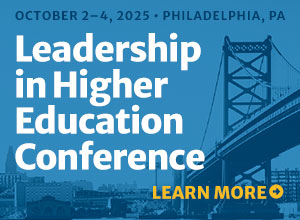Fostering Strategic Autonomy
In geopolitical terms, the phrase strategic autonomy is often used to describe the desire of countries such as India and Turkey to negotiate treaties and engage in military activities without regard for the dictates of a stronger ally or superpower. In corporate or academic terms, strategic autonomy (along with its less mellifluous...
How an Academic Leader Changes a Lightbulb
The very first house I bought was a condominium, and the purchase price included 10 hours of service by an electrician. The idea was that each owner would want to customize the unit with special lighting fixtures and built-in appliances, and covering the cost of the electrician was intended to...
The Wrong Way to Talk about Higher Ed
Picture a day when you’ve gathered your faculty together to have a substantive conversation about some pressing issue facing the institution. You explain the situation using terms such as revenue, the business of education, efficiencies, degree production, throughput, and the like. This may seem sensible given that, in part, universities function like businesses. As with...
Best Practices in Preparing Academic Leaders
It's increasingly common for colleges and universities to offer programs designed to help chairs, deans, and other academic leaders become more effective. Sometimes falling under a center for teaching and learning, at other times existing as an independent office for leadership and professional development, these programs reflect the recognition that...
Proven Tools for Academic Leaders to Successfully Lead Change
Department chairs and deans find that campuswide and unit strategic plans expect them to be change leaders. Add on the complexity of engaging in processes that involve politics, negotiation, persuasion, and inspiration, and change leadership can seem overwhelming.
When Academic Leadership Comes with Baggage
The baggage we bring to work with us can take a variety of forms. It could occur because we applied for our positions as internal candidates and suddenly find ourselves as bosses of the very people who only a short time ago we regarded as close friends. It could occur...
Five Recommendations to Advance Careers in Enrollment and Retention Management
Whether you are an entry-level admission officer or an assistant or associate enrollment manager, you will, at some point in your career, desire to move to the next professional level, either at your current school or at another college or university. These five recommendations may help you make a successful...
Hallmarks of Excellence in Online Leadership
Online learning has “gone from a wild frontier to a more established professional [undertaking],” says Jay Halfond of Boston University, Senior Fellow of the UPCEA Center for Online Leadership and Strategy and Chair of the National Task Force on the UPCEA Hallmarks of Excellence in Online Leadership. As the field...
Academic Leadership at Multicampus Institutions
Although all academic leaders face certain administrative challenges, those who work in a multicampus setting have unique opportunities and problems. The sometimes-difficult balancing act of preserving a single identity throughout the entire institution while also allowing each campus to develop its own distinct personality raises issues that administrators at single-campus...
Leading Change Amid Opposition
When Amanda Gingery Hostalka became chair of art and visual communication design at Stevenson University, one of her priorities was to make sure that learning outcomes for every track and major aligned with the department’s and institution’s missions. The importance of this task was heightened by the department’s upcoming move...












